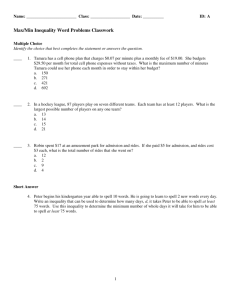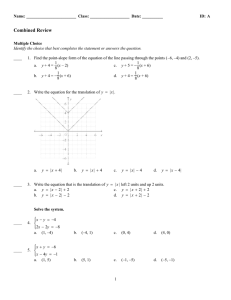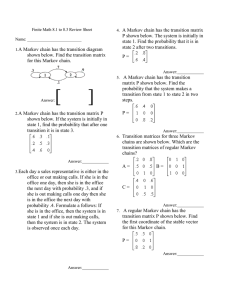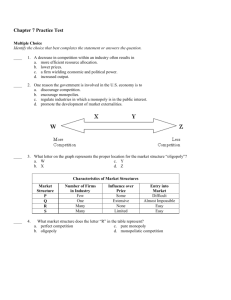multiple choice - Cloudfront.net
advertisement
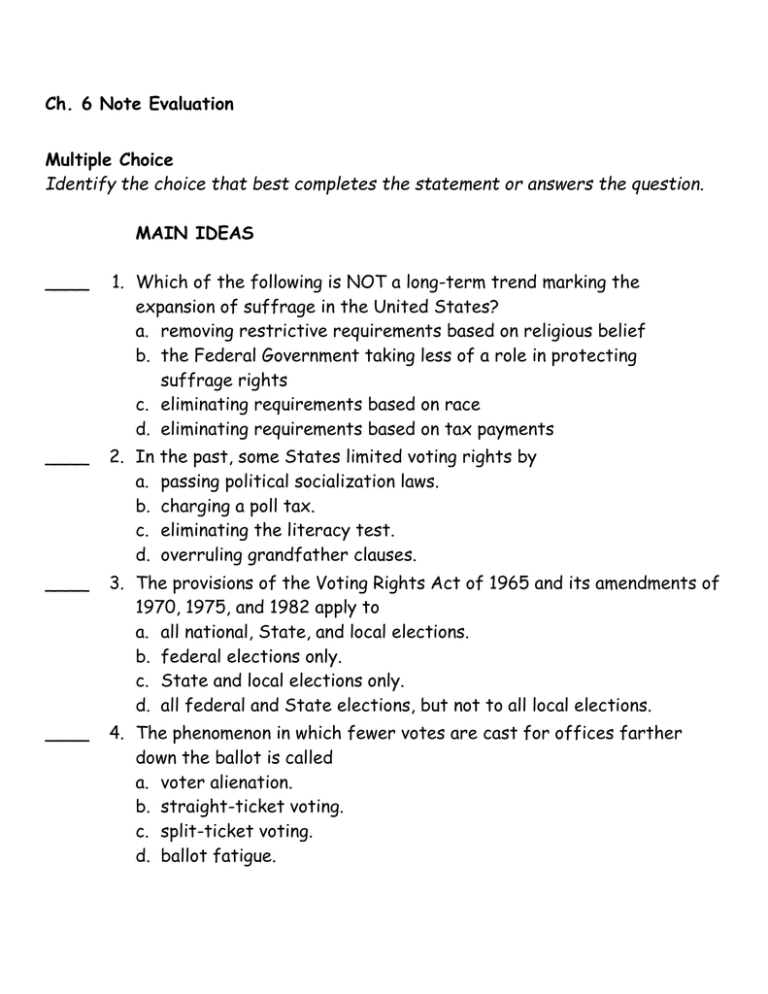
Ch. 6 Note Evaluation Multiple Choice Identify the choice that best completes the statement or answers the question. MAIN IDEAS ____ 1. Which of the following is NOT a long-term trend marking the expansion of suffrage in the United States? a. removing restrictive requirements based on religious belief b. the Federal Government taking less of a role in protecting suffrage rights c. eliminating requirements based on race d. eliminating requirements based on tax payments ____ 2. In the past, some States limited voting rights by a. passing political socialization laws. b. charging a poll tax. c. eliminating the literacy test. d. overruling grandfather clauses. ____ 3. The provisions of the Voting Rights Act of 1965 and its amendments of 1970, 1975, and 1982 apply to a. all national, State, and local elections. b. federal elections only. c. State and local elections only. d. all federal and State elections, but not to all local elections. ____ 4. The phenomenon in which fewer votes are cast for offices farther down the ballot is called a. voter alienation. b. straight-ticket voting. c. split-ticket voting. d. ballot fatigue. ____ 5. All of the following are significant reasons for nonvoting in United States elections today EXCEPT a. long-term mental or physical illness or illness on an election day. b. rules and regulations that make registration and voting cumbersome. c. widespread use of religious and literacy tests. d. apathy or distrust of politics. ____ 6. The term political socialization can be defined as the a. process in which individual initiative is abandoned in favor of party politics. b. belief that one's vote does not count. c. process by which people formulate their political attitudes and opinions. d. practice of voting for candidates of only one specific party in any given election. ____ 7. The expansion of suffrage in the United States a. was outlined in the text of the Constitution. b. was accomplished outside the United States legal system. c. is the subject of all constitutional amendments made since 1810. d. has been moved forward by amendments and civil rights acts. ____ 8. Literacy tests worked to deny the right to vote to African Americans primarily because a. all white voters had higher literacy rates. b. the tests were only required in Southern States. c. African Americans were asked questions that were more difficult than those asked of prospective white voters. d. it was specifically provided for in the Constitution. ____ 9. Which act first established a federal commission to investigate claims of individual voter discrimination? a. Civil Rights Act of 1957 b. Civil Rights Act of 1960 c. Civil Rights Act of 1964 d. Voting Rights Act of 1965 ____ 10. Today many States require that all voters a. be citizens of the United States and residents of the State. b. meet specific literacy requirements. c. be familiar with the candidates and issues before voting. d. be natural-born citizens of the United States. ____ 11. The single most significant predictor of a person's partisan voting behavior is his or her a. party identification. b. educational background. c. political efficacy. d. perceptions of government. ____ 12. The 15th Amendment, ratified in 1870, did not secure the right of African Americans to vote primarily because a. it did not state that voting rights could not be denied to African Americans. b. the Federal Government did not intervene to uphold the amendment. c. it was repealed by Congress shortly after ratification. d. it prevented State leaders from acting on behalf of potential voters who were being discriminated against. ____ 13. Gerrymandering is unfair because a. no one has the right to divide electoral districts for elections. b. it sets district boundaries to decrease one group's voting strength. c. it makes voter registration difficult for uneducated white males. d. it increases the voting power of minority groups. ____ 14. The amendments to the 1965 Voting Rights Act a. eliminated all literacy qualifications. b. broadened the law’s preclearance provisions to cover other minority groups. c. required ballots to be printed in both English and the language of the minority involved d. all of the above ____ 15. As party identification has weakened, a. the number of independents has grown. b. sociological factors have declined in importance. c. the need for candidates of outstanding capability has declined. d. voters have tended toward the Democratic Party. Ch. 6 Note Evaluation Answer Section MULTIPLE CHOICE 1. 2. 3. 4. 5. 6. 7. 8. 9. 10. 11. 12. 13. 14. 15. B B A D C C D C A A A B B D A Ch. 8 Note Evaluation Matching IDENTIFYING KEY TERMS Match each item with the correct statement below. You will not use all the terms. a. public opinion poll b. opinion leader c. public opinion d. quota sample e. random sample f. mandate g. mass media h. sound bite ____ ____ ____ ____ ____ 1. governmental or political attitudes held by a significant number of people 2. the instructions voters give to their elected officers 3. a sample constructed to represent the major characteristics of the universe 4. a sample in which each member of the universe has an equal chance of being included 5. means of communication that reach widely dispersed audiences at the same time Multiple Choice Identify the choice that best completes the statement or answers the question. MAIN IDEAS ____ 6. Public opinion is made known through all of the following EXCEPT a. b. c. d. interest groups. personal contacts. the media. peer groups. ____ 7. Politicians want to have accurate information about public opinion because they can a. plan better campaigns if they know what is important to the people. b. work to discredit public opinion that differs from the views of their political party. c. evaluate whether public opinion on an issue is right or wrong. d. withdraw from a race rather than face defeat for holding an unpopular opinion. ____ 8. All of the following have a major influence on the opinion-making process EXCEPT a. religious leaders. b. peer groups. c. historic events. d. interest groups. ____ 9. The term "public opinion" is misleading because a. opinions have no place in politics or government. b. Americans belong to many different publics, each with a distinctive viewpoint. c. most Americans consider political opinions to be a private matter. d. no two people in the public really agree on any issue. ____ 10. The most reliable measure of public opinion is a. straw votes. b. quota samples. c. scientific polls. d. pressure groups. ____ 11. Polls are taken to a. b. c. d. guarantee the constitutional rights of all people. determine people's attitudes and viewpoints. further the political socialization of individuals. provide a system of checks and balances. ____ 12. The impact of the mass media on the public agenda can best be described as its ability to a. tell people whom to vote for. b. focus the public's attention on specific issues. c. tell people what opinions to have about those issues. d. focus the public's attention on how to vote. ____ 13. All of the following are examples of the difficulties associated with measuring public opinion EXCEPT a. the intensity of the opinions expressed. b. the stability or changeability of an expressed opinion. c. stimulating discussion about them. d. determining the relevance of an expressed opinion. ____ 14. Which form of mass media is now the principle source of political information for about 80 percent of the population of the United States? a. radio b. television c. newspapers d. magazines ____ 15. "Universe" is a term used to describe a. a politician's constituency. b. the entire group of persons sampled in a given poll. c. the entire group of persons whose opinions a poll seeks to measure. d. the group that supports the activities of an interest group. ____ 16. Which of the following is the earliest and one of the most significant agents in the political socialization process? a. family b. place of residence c. group affiliation d. gender ____ 17. What would be your BEST advice to a person who wants to learn more about political issues? a. Watch only television news and commentary shows daily. b. Pay attention only to newspaper stories. c. Explore a variety of sources of political information. d. Regularly read the major newspapers and news magazines. Ch. 8 Note Evaluation Answer Section MATCHING 1. ANS: OBJ: 2. ANS: OBJ: 3. ANS: OBJ: 4. ANS: OBJ: 5. ANS: OBJ: C 8.1.1 F 8.2.1 D 8.2.3 E 8.2.3 G 8.1.3 PTS: STA: PTS: STA: PTS: STA: PTS: STA: PTS: STA: 1 12.8.3 1 12.2.4.b 1 12.2.4.b 1 12.2.4.b 1 12.8 DIF: TOP: DIF: TOP: DIF: TOP: DIF: TOP: DIF: TOP: Easy REF: Public Opinion Easy REF: Mandate Easy REF: Quota Sample Easy REF: Random Sample Easy REF: Mass Media 209 PTS: STA: PTS: STA: PTS: STA: PTS: STA: PTS: STA: PTS: STA: PTS: 1 12.2.4.b 1 12.2.4.b 1 12.2.4.b 1 12.2.4.b 1 12.2.4.b 1 12.2.4.b 1 DIF: TOP: DIF: TOP: DIF: TOP: DIF: TOP: DIF: TOP: DIF: TOP: DIF: Average REF: 209 Public Opinion Average REF: 209 Public Opinion Average REF: 209 Public Opinion Average REF: 209 Public Opinion Average REF: 209 Public Opinion Average REF: 217 Public Opinion Polls Average REF: 211 216 219 218 211 MULTIPLE CHOICE 6. ANS: OBJ: 7. ANS: OBJ: 8. ANS: OBJ: 9. ANS: OBJ: 10. ANS: OBJ: 11. ANS: OBJ: 12. ANS: D 8.2.1 A 8.2.4 D 8.2.5 B 8.1.1 C 8.2.2 B 8.2.2 B 13. 14. 15. 16. 17. OBJ: ANS: OBJ: ANS: OBJ: ANS: OBJ: ANS: OBJ: ANS: OBJ: 8.3.2 C 8.2.4 B 8.3.3 C 8.2.3 A 8.1.2 C 8.3.2 STA: PTS: STA: PTS: STA: PTS: STA: PTS: STA: PTS: STA: 12.8.2 1 12.2.4.b 1 12.8.2 1 12.2.4.b 1 12.2.4.b 1 12.2.4.b TOP: DIF: TOP: DIF: TOP: DIF: TOP: DIF: TOP: DIF: TOP: Mass Media Average REF: 217 Public Opinion Polls Average REF: 211 Mass Media Average REF: 218 The Polling Process Average REF: 210 Political Socialization Average REF: 209 Public Opinion

